1 Introduction
A common vision shared in our Lyon and Orsay laboratories has been, for years, the combination of the use of clean solvents and the use of renewable starting materials. Our different backgrounds in carbohydrate chemistry and catalysis have led us to explore complementary aspects of carbohydrate chemistry in water, at the fundamental and applied levels.
Carbohydrates, which include small sugars, oligosaccharides and polysaccharides, are without doubt the largest reservoir of raw materials for the after-oil era of chemical industry. The realization that carbohydrates are valuable starting chemicals is not recent, and important contributions to this field have been achieved, notably in the field of surfactants, polymers, and functional materials [1]. However, with respect to such low- or medium-added value products, a difficulty is still to develop simple and short processes with reasonable economic viability. Indeed, the structural complexity of carbohydrates makes them generally chemically sensitive and moderately thermally stable.
Water, which is non-toxic, reasonably cheap, is one of the media which cope with the principles of green chemistry. Also, water shows significant advantages in storing and handling compared to many solvents. Yet after being used as a solvent, it becomes a waste just as any other waste; wastewater treatment is nowadays an accomplished technology. In terms of chemical characteristics, water is known for two aspects as a solvent, firstly its protic and polar character, and secondly, its high cohesive energy density which is the physicochemical origin for developing hydrophobic effects.
Unprotected carbohydrates are polyols which exhibit generally good solubility in water. It was thus of interest to explore their reactivity in aqueous media, the selectivity of their transformations, and the design of specifically adapted catalysts, with the perspective of applications as several functional compounds of potential industrial interest. Many reactions can be performed on carbohydrates in aqueous media [2]. This includes C-C bond formation reactions such as Knoevenagel condensations, Barbier-type reactions, Baylis-Hillman reactions, electrophilic aromatic substitution reactions. Also, C-N bond formation reactions have been well explored, including notably reductive amination. This latter reaction, being efficient and very general, has been widely used for preparing new surfactants from many different sugars, e.g. glucose, lactose and isomaltulose [3]. Of course, the functionalization of hydroxyl groups is an important part of this chemistry, including esterification, etherification, carbamatation, and oxidation reactions. In the following sections, some work in this field achieved in our Lyon and Orsay laboratories is briefly reviewed.
2 Esterification and carbamatation of non anomeric hydroxy groups in water
The esterification and carbamatation reactions have been investigated in water using sucrose, a typical example of “non reducing” sugar. Sucrose is not soluble in many solvents, and those which are the most often used, DMF, Me2SO or pyridine, are problematic when considering targets of industrial relevance. Sucrose being very soluble in water, this becomes a solvent of choice. Most sucrose chemistry deals with the transformations of its three primary and five secondary hydroxyl groups, different degrees of substitution (mono-, di-…) and different positions of the substituents on the disaccharidic arising from these two types of selectivities [4]. One way for controlling the stereochemical outcome of the reaction is connected with variations in OH group reactivity. In sucrose, electron-withdrawing effects and an intramolecular hydrogen bond network make OH-2, OH-1” and OH-3’ more reactive and contribute to the conformation of the molecule [5]. Even in water the network is maintained, involving a bridging water molecule between O-2 and OH-1’ as proved by NMR and molecular modeling [6]. All this results in a rather high acidity for sucrose (pKa = 12.6) compared to regular alcohols, and to water [7]. This peculiar acidity of sucrose compared to water might allow reactions even with water-sensitive reactants. A first study of the possibility of using water as an alternative solvent concerned the esterification of sucrose, which can lead either to polymerisable compounds or to amphiphilic derivatives, these latter being used as food and cosmetic emulsifiers. Methacryloyl esters were obtained by reaction with methacryloyl chloride in good yields in an aqueous or hydro-organic medium (Scheme 1) [8]. Starting from very concentrated sucrose solutions, thus limiting the amount of water, competitive hydrolysis of the acid chloride was limited.

Preparation of sucrose esters, carbonates and carbamates in aqueous basic medium (only one of the major isomer is depicted for better clarity though reactions give mixtures of several regioisomers of various degrees of substitution and position).
For longer acid chlorides, such as octanoyl chloride, the reaction is affected by hydrophobic effects. Indeed, the heterogeneity appears to be a critical parameter [9]. At high sugar concentration (low water content) fair yields of sucrose esters, presenting a high degree of substitution are obtained. It is known that sucrose enhances hydrophobic effects by strengthening the water structure, driving the reaction to more polysubstitution [10]. This polysubstitution trend can be limited when using DMAP as stoichiometric base because acylpyridinium intermediates are less sensitive to the entropy-driven aggregation forces. High conversion of the fatty chain towards polysubstituted sucrose fatty esters are obtained in this case. Using stoichiometric NaOH (pH 10) and a catalytic amount of DMAP, very good yields were obtained, even in dilute solutions. Here again, extensive polysubstitution was observed at high sucrose concentration. For lauroyl and palmitoyl chlorides, the hydrophobic effect driven polysubstitution was enhanced in pure water. Limitation of this effect was observed in 1:1 water-THF or water-isopropanol mixture [9].
Chloroformates could also be used in aqueous media leading to alkyloxycarbonyl derivatives (Scheme 1). A typical procedure was the addition of allyl chloroformate to a 40% (w/w) sucrose solution in water at pH 10 and 2 °C. With such a short chain substrate, no effect of the concentration of sucrose in water on the degree of substitution was observed, whereas for octyl chloroformate, polysubstitution was again the natural tendency [11]. A co-solvent and catalytic amounts of DMAP limited this tendency and acceptable yields of monosubstituted products were obtained, as for esterifications.
Isocyanates, although also very water-sensitive, had a chance to react with sucrose in aqueous media (Scheme 1). Regarding the selectivity, a similar outcome as that observed in the case of acid chlorides and chloroformate, i.e. polysusbtitution in pure water and lower degree of substitution in the presence of a co-solvent [12]. However, when the co-solvent is an alcohol, extensive carbamation, isocyanate hydrolysis, and the subsequent carbamic acid and urea derivative formation, were observed as side reactions. Hindered alcohols such as isopropanol and t-butanol were the best co-solvents for obtaining low-substituted products.
In conclusion, the reaction trends for the esterification in water are: (i) sucrose reacts faster than water, therefore even water-sensitive reagents can be used, yet significant competitive hydrolysis can be observed; (ii) low-water content sucrose syrups used as starting material led to limited undesired hydrolysis of the electrophilic species; (iii) for reactions with hydrophobic reagents (targeting amphiphilic products), the medium heterogeneity becomes a key issue, with significant hydrophobic effect driven polysubstitution; (iv) addition of co-solvents and/or catalysts can lower competitive hydrolysis, lower the level of heterogeneity therefore limiting polysubstitution; (v) when amphiphilic targets are considered, intrinsic surfactant properties of these compounds modify significantly the medium during the course of the reaction, leading to a typical autocatalysis behaviour.
3 Etherification reactions
3.1 Hydroxyalkylethers from epoxydes
Amphiphilic hydroxyalkylethers of sucrose were also targeted. These compounds arise from sugars and epoxides (Scheme 2) [13] and possess better chemical stability compared to esters, therefore having a wider scope of potential applications.

Reaction of sucrose with fatty epoxides and their 3-hydroxy counterparts.
The interfacial phenomena involved in such systems were extensively studied, in particular the competition between homogeneous and interfacial reactions. The heterogeneity of the medium changes during the reaction because of the surfactant properties of the compounds, and is also influenced by the nature of the basic catalyst [13,14]. Induction time is also reduced upon better emulsification, which results from the production of the first amphiphilic products, but also from efficient stirring and mixing. The partition of the basic catalyst among the two phases and at the interface plays the most important role. Tertiary amines proved to be the most efficient basic catalysts, due to good solubility in all phases, and likely forming ammonium alcoholates by reaction with the epoxide, this latter species being at the same time more basic and acting as an emulsifier. Addition of CTAB as phase transfer catalyst, improved further the selectivity for low-substituted products [13]. Faster reactions were observed when starting from 3-hydroxy-1,2-epoxides, due to activation of the epoxyde by intramolecular hydrogen bonding and to higher interfacial concentration of the hydrophobic epoxide [15].
The use of heterogeneous catalysts was investigated and the study was extended to two other non-reducing substrates, namely trehalose and isomalt [16]. Interfacial issues were again shown to be critical. Among various ammonium and amino resins, good activity was obtained with a PS–Im catalyst, a polystyrene functionalized with methylimidazole goups. This catalyst combined satisfactory thermal stability with adequate interfacial balance, and possible formation of intermediate ammonium alcoholates by reaction on the epoxide. The PS-NOH resin, though less active at the beginning of the reaction, proved to be also very efficient, leading to more than 87% yield into sucrose ethers [16].
3.2 Palladium-catalyzed condensation of butadiene with sugars and polysaccharides
Many routes are available for the synthesis of mono- or poly-ethers of saccharides, among them the Williamson synthesis or the ring opening of epoxides as mentioned previously [1]. However, these approaches lead to the formation of stoichiometric amounts of salts, which is undesirable. An alternative route for the preparation of long chain substituted ethers is based on the pallado-catalyzed coupling of sugars with butadiene known as the telomerization reaction. This reaction has been largely studied with different nucleophiles such as alcohols, phenol, carboxylic acids, amines and active methylene groups [17]. Using carbohydrates as nucleophiles, the reaction leads to hydrophobic alkyl saccharides which could show interesting physical and chemical properties [18]. Moreover this reaction can be carried out in the presence of water as solvent. In the early nineties, the teams of Mortreux and Hill reported the pioneering telomerization of sucrose in an iPrOH/H2O (NaOH) mixture using Pd(acac)2/PPh3 or Pd(acac)2/TPPTS as catalyst [19]. The sucrose octadienyl ethers with an average degree of substitution up to 5.7 have been obtained depending on the nature of the base, the reaction time and the quantity of butadiene (Scheme 3). The hydrosoluble catalyst was also efficient to perform the telomerization of L-arabinose in the presence of amine as base [20]. The use of co-solvent is essential to increase butadiene solubilization in the liquid phase leading thus to higher conversion.

Telomerization of butadiene with sucrose.
This reaction can be extended to much more complicated substrates such as polysaccharides (starch, cellulose, inulin…) (Scheme 4). As for the mono- and di-saccharides, the reaction was carried out in water media which is strongly compatible but as these substrates exhibit lower reactivity, it is necessary to perform the reaction in the presence of base [21]. Moreover, in that case, low degree of substitution (average number of ether chains per glucoside unit) was sufficient to modify deeply the physical properties of the organic polymer.

Polysaccharides for telomerization.
At high temperature (typically 80–90 °C), in NaOH/iPrOH mixture, in the presence of hydrosoluble palladium catalysts (Pd(OAc)2/3 TPPTS or the complex [(π-allyl)Pd(TPPTS)2]Cl), substituted polysaccharides with low to moderate degrees of substitution were obtained (DS up to 1) [22]. The behaviour of starch complicates the process: at a temperature higher than 50 °C, the native starch gelatinizes and is very difficult to handle. For these reasons, we optimized the reaction in order to prepare substituted starch keeping the texture of the granular native starch (20–100 μm) by addition of Na2SO4 in the reaction medium (Fig. 1).

Scanning electronic microscopy and cross polarization of granular starch (a) before (native starch) and (b) after reaction at 50 °C with Na2SO4.
Optimization of reaction conditions was carried out with the hydrosoluble complex [(π-allyl)Pd(TPPTS)2]Cl (Table 1). As low DS were expected, the butadiene was used as the limiting reactant (0.3 eq/glucose unit). When the amount of co-solvent decreased, the conversion of butadiene, which is insoluble in water, was lower but the catalyst was still active even in pure water (DS = 0.02).
Influence of the presence of iPrOH on the telomerization of butadiene with starcha.
| ViPrOH (mL) | Time (h) | DS | Butadiene conv. (%) |
| 20 | 4 | 0.06 | 80 |
| 10 | 4 | 0.03 | 40 |
| 5 | 4 | 0.03 | 40 |
| 0 | 24 | 0.02 | 30 |
a Reaction conditions: 80 g wet starch, 3.2 g butadiene (0.15 equiv./glucose unit; DSmax = 0.075), 100 mL solvent (water and optionally iPrOH), [(π-allyl)Pd(TPPTS)2]Cl = 0.4 mol% based on butadiene, [Na2SO4] = 12.5%wt/starch, [NaOH] = 1.38%wt, 50 °C.
In order to improve the activity in the absence of co-solvent, Monflier et al. reported that in the presence of neutral or cationic surfactants, the reaction rate of the hydrodimerization of butadiene increased significantly [23]. In our hands, similar behaviours were observed for the telomerization of butadiene with starch [24]. While 30% conversion of butadiene was achieved in pure water after 24 h reaction time at 50 °C using 0.4 mol% of catalyst, up to complete conversion was reached when surfactant was added to the reaction medium under similar reaction conditions. However, the conversion is strongly affected by the nature of the surfactant: the higher the hydrophobic lipophylic balance (HLB) of the surfactant, the higher the butadiene conversion (Fig. 2). The best results were observed in the presence of neutral BRIJ 98® and IGEPAL CO-890® or cationic CTAB surfactant.

Influence of the nature of surfactant on the telomerization (reaction conditions: Table 1, 6 hours).
This was attributed to the formation of micellar aggregates in the reaction medium, which increased mass transfer between organic butadiene and aqueous phase by increasing the solubilization of butadiene within the aqueous solution. For the reaction taking place, all reactants and catalysts have to interact closely; the presence of surfactant allows such interaction (Fig. 3). Physicochemical analysis (contact angle measurement, rheological properties, water adsorption-desorption isotherms) showed that even at low degree of substitution (DS < 0.1), the properties of the modified starch were strongly affected and hydrophobic materials which can be useful for specific applications were prepared [24].

Schematic representation of interactions between starch and micelles.
4 Oxidation reactions
Water is not an unconventional medium for oxidation reactions. Many examples of carbohydrate oxidations have been reported, notably metal catalyzed reactions [25]. Water is also the medium for microbial oxidations, and [26] a typical example is the conversion of sucrose to “3-keto-sucrose” (1) D-glucoside 3-dehydrogenase (the active species in Agrobacterium tumefaciens) (Scheme 5). On the chemical side, sucrose is oxidized by oxygen in presence of platinum to a mixture of mono-, di-, and tricarboxy-derivatives [27], excellent conversion to monocarboxylated sucrose being achieved using electrodialysis, whereas catalyst poisoning limited the yields in more oxidized derivatives. Our work in this field focused on the use of TEMPO as a catalyst for the hypochlorite oxidation of sucrose, a method which had shown efficiency in the case of various carbohydrates, and for which several variations in the catalytic system have been reported for making its environmental impact as satisfactory as possible. Notably, heterogeneous TEMPO analogs and bromide free methods have been reported [28]. From sucrose, we showed that the tricarboxysucrose 2 was obtained in good yields and that under ultrasound, the reaction could be performed in absence of sodium bromide, though at a slower rate [29]. In this reaction, TEMPO is oxidized by sodium hypochlorite to give a nitrosonium ion which is the actual oxidizing species. Ultrasound could possibly induce the formation of trace amounts of chlorine radicals, making the TEMPO oxidation step faster, such a hypothesis being suggested for explaining the effect of sodium bromide, a co-catalyst normally required in the reaction, but unnecessary under ultrasound [28,29].

Oxidation of sucrose in aqueous media.
In another project which is related to the preparation of new carbohydrate-based scaffolds for fine chemistry, we have shown that hydrogen peroxide oxidation of isomaltulose, a cheap commercially available glucose-fructose disaccharide obtained from sucrose by bioconversion, led to carboxymethylglucoside 3 in a moderate 35% yield, though competitive compared to multistep sequences [30]. The oxidation of sugars by hydrogen peroxide is well precedented [31]. Here, the reaction can be catalysed by the presence of tungstate ions, which activate hydrogen peroxide through a metal oxo complex which can react with diols leading to carbon-carbon bond cleavage like in glycolic oxidation. This reaction was described by Venturello and Ricci [32], and then used by Noyori and co-workers for the synthesis of adipic acid from cyclohexene [33]. Recent variations of this reaction involving microemulsions or heterogeneous catalysts have been published recently [34].
Carboxymethyl glycoside 3 was used as an intermediate in the synthesis of CMGL (4), a bicyclic lactone which has since been used as synthon for constructing multifunctional systems in which the carbohydrate serves as a scaffold [35] (Scheme 6).

Oxidation of isomaltulose to CMG and access to new neoglycoconjugates.
Alternatively, a green oxidation of polysaccharides has been developed using H2O2 as oxidant and hydrosoluble phtalocyanine iron complex as catalyst (Scheme 7) [36]. It was proposed that the first oxidation step occurred at the C3 position of the glucose unit to form an α-hydroxy-β-keto intermediate that was further oxidized to the final product via a Grob-type fragmentation (Scheme 8). This reaction was applied not only to starch but also to cellulose, hydroxyethylcellulose, carboxymethylcellulose, guar gum or inulin [37]. A small amount of catalyst was sufficient to achieve efficient oxidation (typically 0.00004–0.0002 equivalent/glucose unit). Polysaccharides bearing aldehyde and acidic groups were so prepared, the DS's depending on the reaction conditions. The introduction of carbonyl and carboxyl groups to polysaccharides gives access to hydrophilic materials that are important for many applications.

Oxidation of starch by the phtalocycanin-H2O2 system.

Proposed mechanism for iron-phtalocyanine oxidation of saccharides [37].
5 C-glycosides
C-glycosides are molecules in which the sugar and aglycon are connected by a C–C bond. Some of them are found in nature, and due to their stability toward both enzymatic and chemical hydrolysis, several methodologies were developed toward the preparation of the carbon-linked analogues of naturally occurring O-glycosides [38]. Some of these isosters show biological properties similar and even better than those of the parent O-glycosides [39]. Most of the preparation of such compounds required the protection of the hydroxyl groups of the sugar and the activation of the anomeric position by the installation of an appropriate leaving group or by oxidation [38]. These transformations require large amount of reagents as well as organic solvents, impacting the E factor [40]. By contrast, Lubineau's group developed an efficient synthesis of β-C-glycosidic ketones by using the Knoevenagel condensation in water without any protecting group (Scheme 9) [41].

The Lubineau reaction towards C-glycosides.
This transformation involves the Knoevenagel condensation, a simple reaction for carbon-carbon bond formation by reacting activated methylene and carbonyl compounds [42], favoured in water in some cases although it involves a dehydration [43]. In fact, the Knoevenagel reaction of unprotected sugars was already investigated in methanol in the 1950s using zinc chloride as promoter [44]. This transformation has been reinvestigated with the emergence of new water tolerant catalysts having Lewis acid behavior affording an entry to trihydroxylated furan derivatives 5 from pentose or β-tetrahydrofuranylfuran 6 from hexoses with non cyclic β-dicarbonylic compounds [45], or other valuable compounds such as the hydroxyalkyl fused heterocycles 7 or 8 using dimedone as cyclic β-dicarbonylic derivative and d-ribose (Scheme 10) [45,46].

Quite surprisingly, the Knoevenagel reaction of unprotected carbohydrate under basic conditions has been less investigated. The first report on the topic dealt with the condensation of d-glucosamine with pentane-2,4-dione in aqueous acetone in the presence of sodium carbonate affording the pyrrole derivative 9 (Scheme 11) [47]. Later on, the reaction was extended to other reducing amino sugars and carbon nucleophiles [48]. The condensation of unprotected aldoses under basic conditions was also studied using barbituric acids to afford the C-glycosyl barbiturates 10 [49].
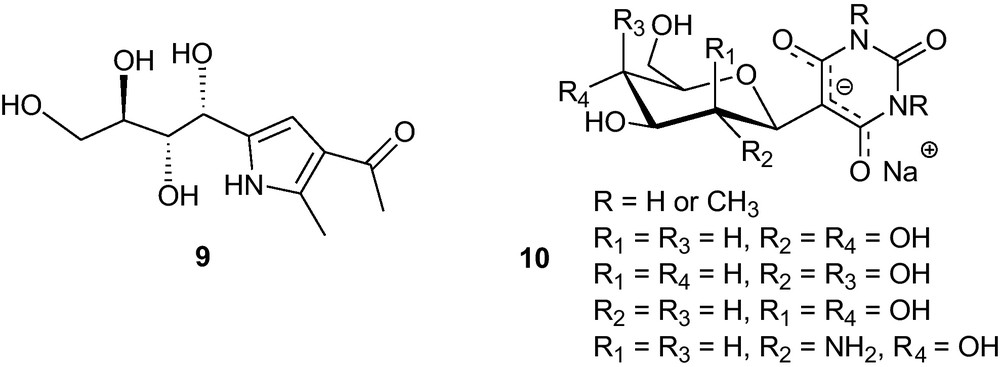
As mentioned above, the conditions found by Lubineau's group allowed for the preparation of β-d-C-glycosidic ketones by condensation of pentane-2,4-dione with unprotected sugars in alkaline aqueous media [41]. The Knoevenagel condensation of the β-diketone with d-glucose affording 11 was followed by β-elimination of water to give 12 (Scheme 12). This intermediate then gave rise to an intramolecular Michael addition affording cyclisation to the intermediate C-glycoside 14, most likely as mixture of the four possible α, β-furanosides and α, β-pyranosides stereoisomers, since when the reaction was conducted at room temperature, a mixture of the four isomers 15a,b,c,d in which the α−pyranoside 15b predominated, was obtained through a retro-Claisen aldolisation with concomitant sodium acetate elimination. Under further equilibration in basic medium, an almost exclusive formation of the β-glucopyranoside (equatorial) stereoisomer 15d was obtained from a thermodynamic control.
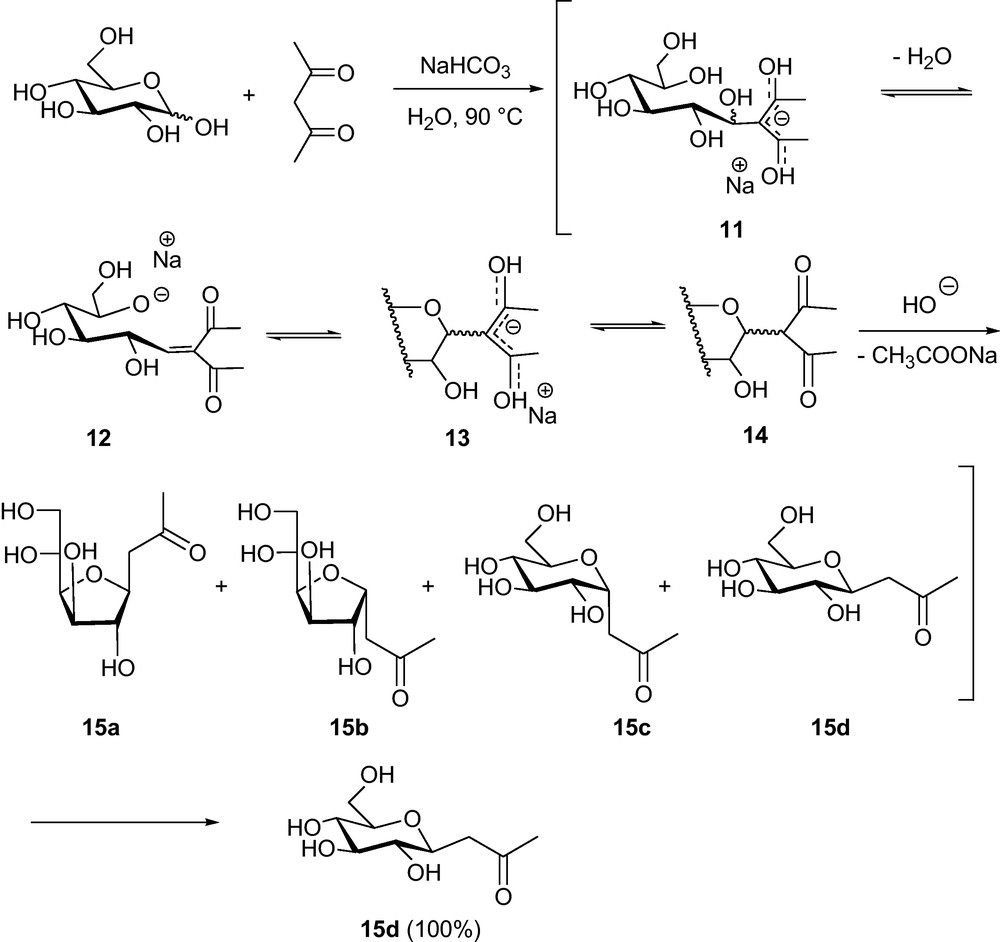
d-Mannose, d-galactose, d-maltose and d-cellobiose gave similarly the β-C-glycosidic ketones 16, 17, 18 and 19 respectively (Scheme 13) [41,50,51]. These results have to be compared with the previous syntheses of 15d and 19 prepared in seven and eight steps, respectively, and low overall yields from commercial 2,3,4,6-tetra-O-benzyl-d-glucopyranose [52].
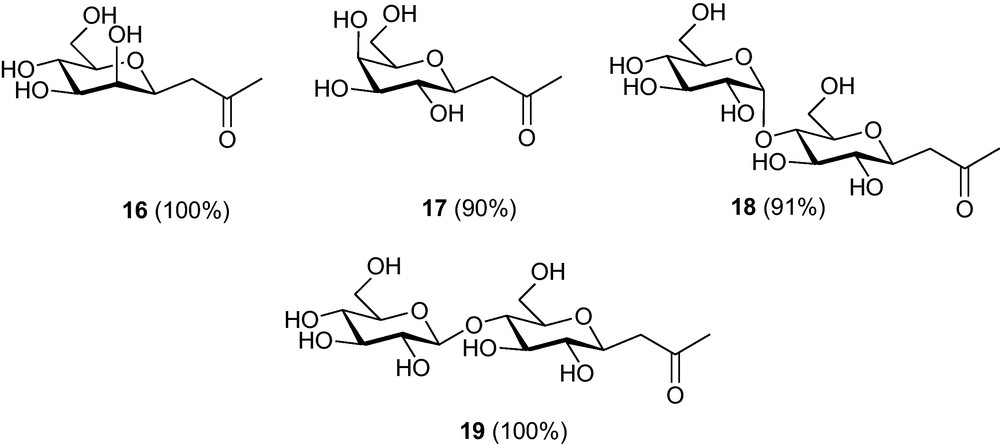
Cavezza et al. applied the reaction to pentoses such as d-xylose, d-fucose, d-arabinose, and 3-deoxy-d-arabinose and to the disaccharide d-lactose [53], to prepare the corresponding β-d-linked ketones 20–24 in excellent to moderate yields (Scheme 14). The base used for the preparation of 20 was carefully studied in order to optimize the synthesis of 25, an activator of glycosaminoglycans biosynthesis, launched on the market by L’Oréal on 2006 in cosmetic skincare products as Pro-XylaneTM [54].
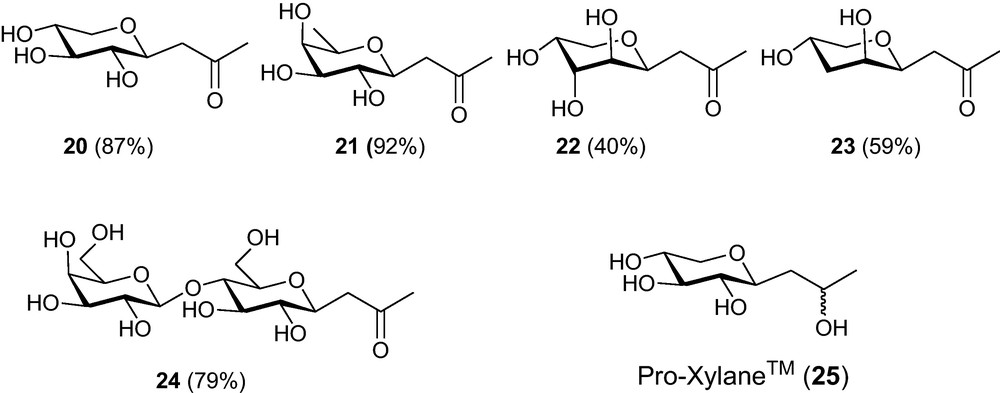
We then investigated the condensation of pentane-2,4-dione with unprotected N-acetyl-d-gluco-, manno-, and galactosamine in alkaline aqueous media [51] and demonstrated that, unlike reported by others [55], N-acetyl-d-glucosamine and N-acetyl-d-mannosamine gave rise to a mixture of gluco and manno C-glycosidic ketones 26a and 27a through an epimerization at C2 of the starting sugar and of an intermediate during the reaction (Scheme 15). The two stereoisomers can be separated as their acetylated derivatives 26b and 27b. Using optimized conditions (2, 4 pentanedione 2 equiv, NaHCO3 4 equiv, H2O-THF 2:1, 90 °C, 24 h), N-acetyl-d-glucosamine gave a 83% yield of the gluco- and manno ketones 26a and 27a in a 4:6 ratio. N-acetyl-d-mannosamine led to the same products in a 3:1 ratio and only 40% yield since 27a was found to be unstable in the reaction mixture. Using the same reaction conditions, N-acetyl-d-galactosamine afforded the C-glycosidic ketone 28a, isolated as the acetylated compound 28b in 50% yield.

Unsymmetrical diketones as nucleophilic species were also investigated in this reaction [55]. In particular, these were tested in the condensation of diketones 29a and 29b, assuming that the acetate elimination in the intermediate 30 should be favored toward the elimination of the shorter chain carboxylate residue and should therefore afford C-glucolipids 31 rather than propanone C-glucoside 15d (Scheme 16) [50]. The reaction of glucose with decane-2,4-dione 29a and NaHCO3 in water (90 °C, 48 h) gave a mixture of C-glycolipid 31a and the propanone C-glycoside 15d in a 2:1 ratio and 56% total yield. When the less soluble tridecane-2,4-dione 29b was used, the reaction led to a complex mixture from which no major products could be isolated. Making the long chain diketones more soluble by the use of EtOH as a co-solvent improved the yields of the reaction to 94% with 29a and 90% with 29b but no selectivity of the elimination of sodium acetate rather than sodium heptanoate or sodium decanoate was obtained. Hence, symmetrical β-diketones 32a and 32b were successfully used in the condensation with d-glucose and d-maltose in EtOH/H2O as the solvent and NaHCO3 as the base giving the C-glucolipids 31a and 31b in 75% and 52% yields and the C-maltolipids 33a and 33b in 65% and 30% respectively.
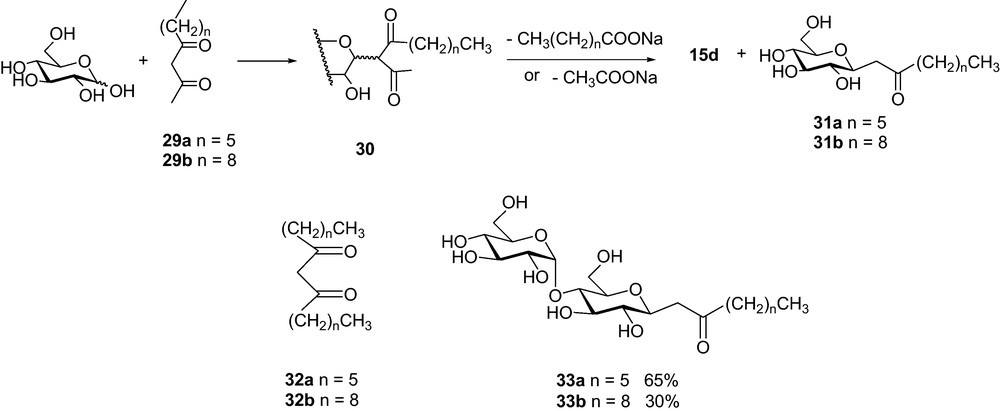
As illustrated here, the Knoevenagel reaction of unprotected sugar in alkaline aqueous medium is a valuable green methodology for the synthesis of β-D-C-glycosidic β-ketones that has been exploited to prepare various targets by us as illustrated here, and consecutively by other groups [53–56]. The efficiency of this easy to perform reaction has also given an entry to synthetically useful building blocks [57]. This method, together with the use of β-ketophosphonate as unsymmetrical activated carbonyl substrate recently reported by Benvegnu and co-workers [58], shows how much unprotected carbohydrate can be efficiently transformed into C-glycosides.
6 Conclusion
Chemical transformations of sugars in aqueous media include OH group derivatisations and additions at the anomeric carbon, leading to many types of synthons and functional products. Sugars are polyols which exhibit peculiar reactivity allowing favorable competition versus water when water-sensitive reagents are involved. The issue of selectivity is not always easy to monitor, but not all applications require highly selective processes. For the field of carbohydrate-based surfactants, medium heterogeneity appears to be a major issue, with a natural tendency towards polysubstitution which has to be modulated by specific addidtives, co-solvents (alcohols) and catalysts. With respect to the anomeric position, the hemiacetalic-carbonyl equilibrium allows many reactions, among which C-glycoside formations. In many cases, catalysis appears to be an essential tool for the use of carbohydrates as renewable starting materials in direct processes performed in aqueous media. Some of these approaches have led to new derivatives having significant industrial prospect.
Acknowledgements
The authors want to express their deep thanks to André Lubineau, Gérard Descotes and Pierre Gallezot for their constant support and acknowledge their accomplishments in the field of clean processes for carbohydrate chemistry. They thank the CNRS and the Ministère de l’Enseignement Supérieur et de la Recherche for financial support. YQ acknowledges the Béghin-Say (Tereos) company for financial support of some of the work presented as well as Juliette Fitremann and Alain Bouchu of the former UMR 143 Sucrochimie Unit, and Joël Barrault and François Jérôme of the Poitiers LACCO laboratory. YQ gratefully acknowledge the University of Hull for the appointment as Honorary Professor and want to express his deepest thanks to Grahame Mackenzie for his support and the fruitful collaborations over the past 10 years. CP is greatly indebted to the European Commission (contract Hydrostar, GDR1-1999-10200) and Roquette Frères for financial supports to her projects. MCS thanks L’Oréal for financial support of part of the C-glycoside project.


